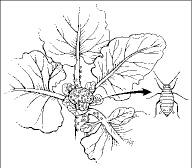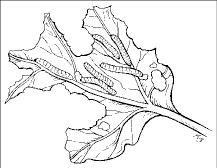Vegetable Gardening (119 page)

 Good bugs are smart; they hang out in the gardens that offer the most diverse and reliable menu. That's why eliminating every last insect pest from your garden isn't a good idea. To get the good insects to stick around, follow these tips:
Good bugs are smart; they hang out in the gardens that offer the most diverse and reliable menu. That's why eliminating every last insect pest from your garden isn't a good idea. To get the good insects to stick around, follow these tips:
 Avoid indiscriminately using broad-spectrum chemical or organic pesticides, which kill everything, the good bugs and the bad.
Avoid indiscriminately using broad-spectrum chemical or organic pesticides, which kill everything, the good bugs and the bad.
If you do spray, use a spray that specifically targets the pest that you want to eliminate and that has minimal effect on beneficial insects; the label on the spray usually gives you this information. (I discuss safe sprays in detail later in this chapter.)
 Plant a diverse garden with many kinds and sizes of plants, including flowers and herbs.
Plant a diverse garden with many kinds and sizes of plants, including flowers and herbs.
Doing so gives the beneficials (beneficial insects) places to hide and reproduce. A garden with a variety of plants also can provide an alternative food source, because many beneficials like to eat pollen and flower nectar, too. Some plants that attract beneficials include Queen Anne's lace, parsley (especially if you let the flower develop), sweet alyssum, dill, fennel, and yarrow.
 Provide a diverse habitat for beneficial insects.
Provide a diverse habitat for beneficial insects.
Have a small bird bath and evergreen and deciduous shrubs to hide in nearby. These elements provide water and shelter for beneficial insects, making it more likely they'll hang around to munch on some insect pests.
The bad-bug roundup
It helps to know your enemy, and insect pests command the largest army of invaders. The following sections list the most common insect pests that are likely to infest your vegetables as well as the best ways to control them. You can find control measures for the pests that prey primarily on specific vegetables in the individual descriptions of those vegetables in Part II; I also provide general points for tackling bad bugs in the later section "Methods of attack."
 If you need more help identifying garden pests and other plant problems, contact a full-service garden center with a variety of reference books that you can look through as well as employees who have personal experience with local problems. Also check with botanical gardens, libraries, Web sites, or a local Cooperative Extension Service office. You should be able to find your county office listed under county offices (these services are usually managed by area land-grant universities) or under
If you need more help identifying garden pests and other plant problems, contact a full-service garden center with a variety of reference books that you can look through as well as employees who have personal experience with local problems. Also check with botanical gardens, libraries, Web sites, or a local Cooperative Extension Service office. You should be able to find your county office listed under county offices (these services are usually managed by area land-grant universities) or under
Cooperative Extension
or
Farm Advisor.
Often a well-trained home gardener called a Master Gardener is available by phone or in person to answer your gardening questions. (Check the appendix for state Master Gardener contacts.)
Aphids
Aphids
are tiny, pear-shaped pests that come in many colors, including black, green, and red (see Figure 17-1). They congregate on new growth and flower buds, sucking plant sap through their needlelike noses. Heavy infestations can cause distorted growth and may weaken your plants. Aphids leave behind a sticky sap that may turn black with sooty mold and may carry diseases, such as viruses, that infect your plants. Many vegetables can be infested with this pest, including cabbage, cucumbers, and broccoli.
Figure 17-1:
Control aphids with insecticidal soap, neem oil, or hot pepper spray.
Aphids are easy to control. A strong jet of water from a hose can knock them off sturdy plants (they rarely climb back onto the plant to feed), or you can use insecticidal soap or neem oil. Insecticidal soap also helps wash off the sooty mold. (I talk more about insecticidal soap and neem oil in the later section "Methods of attack.") But if you have only a few aphids, wait a week for beneficial insects, especially lady beetles, to move into your garden; they usually take matters into their own hands before serious damage occurs.
Caterpillars and worms
Caterpillars and worms, moth and butterfly larvae, are avid eaters and can cause a lot of damage to a variety of plants. Some are hairy caterpillars; others are smooth skinned and more wormlike. Caterpillars include tomato hornworms and cabbageworms (see Figure 17-2), which are described in Chapters 4 and 9 respectively. You can handpick caterpillars and worms to reduce numbers, or you can release trichogramma wasps. But the most effective way to get rid of them is to spray with biological controls, such as Bt or spinosad. (You can read more about Bt and spinosad in the later section "Methods of attack.")
Figure 17-2:
Handpick the cabbageworm caterpillars that are noshing on your plants or spray with Bt.
Corn earworms
Corn earworms
are a common pest wherever corn is grown. These 1 1/2-inch-long caterpillars with alternating light and dark stripes may be green, pink, or brown. In spring, night-flying moths lay yellow eggs on the undersides of leaves. The resulting first-generation caterpillars feed on the leaves. The eggs of later generations can be found on corn silks; the emerging caterpillars feed on the silks and the kernels at the tips of the corn ears, just inside the husks. The earworms, also called fruitworms, attack a variety of plants including tomatoes, beans, peas, peppers, potatoes, and squash.
The easiest way to deal with corn earworms on your corn plants is to just cut off the tip of the ear before you cook it. Or to prevent worms, you can spray Bt before the caterpillars enter the ears or fruit, but that doesn't always work. To prevent the worms from entering the ears, you also can place a few drops of mineral oil on the silks of each ear just as the silks wilt and start to turn from white or yellow to brown. (Don't do it too early or you'll interfere with pollination, but don't wait until the silks are all brown and shriveled either; you have about a week in which to work.)
Cutworms
Cutworms
are 1/2-inch-long, grayish caterpillars. They emerge on spring and early summer nights to eat the stems of young seedlings, causing the seedlings to fall over like small timbers. Cutworms also climb up to older plants and feed on leaves and flowers.
To protect seedlings, surround their stems with barriers that prevent the cutworms from crawling close and feeding. These devices can be as simple as empty cardboard toilet paper rolls, Styrofoam cups with the bottoms cut out, or collars made from aluminum foil. Whatever you use, just make sure that the barriers encircle the stem completely and are set 1 inch deep in the soil. You also can trap cutworms by leaving boards around your garden; the worms hide under the boards during the day, enabling you to collect them. Parasitic nematodes also are effective against cutworms. (Flip to the earlier section "In with the good bugs" for more on these good pests.)
Flea beetles
Flea beetles
are tiny 1/16-inch beetles that feed on vegetable leaves, riddling them with small holes. These beetles jump rapidly when disturbed, like fleas — hence their name. Various species feed on just about any plant in a garden, including eggplant, tomatoes, broccoli, cabbage, corn, potatoes, spinach, peppers, and sweet potatoes. Adult beetles can spread diseases — wilt in sweet corn, for example — and larvae feed on roots. Adults overwinter in the soil and on garden debris, emerging in early spring. Keep a close watch because these beetles can destroy young plants quickly.


